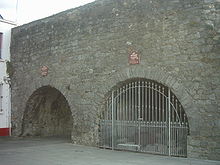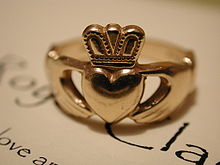Usuario:Alvertov/Taller

The Galway City Museum (en irlandés: Músaem Cathrach na Gaillimhe) is a museum in Galway City, County Galway, Ireland. It was founded on 29 July 2006, and is located beside the Spanish Arch. The official website for the museum was launched on 27 November 2008.[cita requerida]

Origen y Desarrollo
[editar]El Museo de la Ciudad de Galway fue fundado a mediados de 1970. Esta localizado originalmente en "Comerford House", que anteriormente había sido el hogar de la artísta Clare Sheridan. El museo inició como una colección de piedras medievales de la ciudad, adquiridas por Sheridan. Administrado por Michael Keany, Bill Scanlan and Jim Higgins el museo se basó en una colección de folklore, y artículos industriales y militares.[1]

La Casa Comerford
[editar]La Casa Comerford es una propiedad histórica donada al Ayuntamiento de la Ciudad de Galway por la familia Comerford con la finalidad del uso comunitario. La casa fue construida en 1800 como propiedad privada, originalmente vivía la familia Comerford y después fue habitada por la familia Greenwood. Clare Consuelo Sheridan [(1885-1970), escultora, periodista y escritora; y, primera prima de Sir Winston Churchill], vivió en la casa Comerford entre 1948 y 1954.[2]
La casa se volvió parte de la administración de la Corporación Galway por un período antes de que el Museo de la Ciudad de Galway fuera fundado en 1976. El museo cerró en 2004.
El Nuevo Edificio del Museo
[editar]En Abril de 2007 se inauguró un nuevo museo, detrás del viejo museo en la casa Comerford. El proyecto del nuevo Museo de la Ciudad de Galway fue una iniciativa del Ayuntamiento de la Ciudad de Galway para promover la vida cultural y el patrimonio de la Ciudad de Galway. El edificio fue diseñado por Ciaran O'Connor y Ger Harvey, arquitectos de obras públicas, que fueron contratados por el Ayuntamiento de la Ciudad de Galway. El nuevo museo está localizado a lo largo del Río Corrib, junto al Arco Español; un monumento protegido que forma parte de la pared defensa medieval que alguna vez rodeó a la ciudad de Galway. El diseño del edificio crea una plaza o cuadra entre el museo y el Arco Español, un espacio público que algunas veces es usado como espacio para actos cívicos.
Los planos del museo están diseñados en forma de "L" y estaba restringido a tres niveles para mantener la forma de los museos a su alrededor. El proyecto fue terminado en 2006 el ocupa un espacio de 2,100 m² con un costo total de €6,890,000.00. Los arquitectos del edificio ganaron en 2006 el "Bank of Ireland Opus Architectural Award" por el diseño del mismo.[3]
El Nuevo Edificio del Museo
[editar]Museo de la Ciudad de Galway el día de hoy
[editar]En la actualidad el museo alberga una variedad de exposiciones permanentes y temporales. Las exposiciones permanentes incluyen; "Routes to the Past" (Visión Pre-Histórica de Galway), "Galway Within the Walls" (Galway Medieval), "Man and Statute", "Dance Hall Days", "Cinema in Galway" y "Galway and the Wars of Empire". Las exposiciones temporales han incluido "Between Art and Industry" y "Water and Life" (una exhibición sobre la herencia de las personas, lugares, barcos y agua.[4]
Museum Collection
[editar]Galway City Museum collects, preserves and displays materials relating to the history of Galway City; Archaeology, Art, Geology, Natural History, Social, Political and Industrial History and Folklife. The museum began as a collection of medieval stones acquired by artist Claire Sheridan of Comerford House and, over the years expanded to include general folk life, industrial and militia objects.
In April 2007 the new purpose built museum building was opened, located behind the site of Comerford House. The new building houses the collections of the previous city museum, as well as objects acquired for the new facility, although the majority of the collection is that which was inherited from Comerford House. The Comerford House collection includes almost 1,000 objects relating to various periods in history, collected over a period of about thirty years.[5]
Permanent Collection
[editar]- DJ Murphy Collection:
Consists of over three hundred mainly farm and industrial implements, mainly from Galway County. The collection also includes some rare straw items objects relating to traditional Irish rural life Consiste en más de 300 implementos industriales, de granja, principalmente de Galway. La colección también incluye algunos instrumentos raros relacionados con la tradicional vida rural Irlandesa
- Medieval Stone Collection:
Various carvings and architectural fragments which date mainly to the sixteenth and seventeenth century Galway City. It includes chimney pieces, corbels, armorial plaques and heraldic panels. The collection also includes two complete fireplaces and the Atty Doorway dating to 1577.
- One of the fireplaces dates to 1615 and is from the Slate House Nunery, Kirwins Lane. The second, also from the seventeenth century, bears the arms from the Lynch and Henry families and originates from a house in High Street.
Many pieces in this collection pertain to buildings which are no longer in existence and are associated with families of the Tribes of Galway.
- Galway Militia Artefacts:
Objects relating to the Connaught Rangers, which belonged to Galwegians who fought in various wars, from the Crimea War to World War I and World War II
- Claddagh Collection:
A collection relating to the history of the Claddagh, in particular the Claddagh apron and shawl. It also includes a model of the layout of the Claddagh village in the early twentieth century.
- Maritime Collection:
A selection of fishing boats, navigation books, an Aldis lamp and the boat building tools of John Reney. Reney is regarded as the last of the Claddagh’s boat builders and his building yard was formerly adjacent to the site of the new museum.
- Nineteenth and Twentieth Century Galway:
A collection of objects relating to nineteenth and twentieth century shops, public houses and business in Galway, including Persse’s Whiskey Distillery (Lady Gregory was a member of this family), Young’s Hibernian Mineral Water Works, clay pipe factories and a receipt book from one of the Magdalene Launderies or Magdalene Asylum.
- Derek Biddulph Photographic Collection:
A series of photographs from Galway based artist Derek Biddulph which document the city from the 1950s onwards
- Art Collection:
Tiger Lillies, a painting, and a carving of the Madonna and Child by artist Clare Sheridan, previous resident of the former museum at Comerford House. Also, Cecil Maguire’s painting of "Bridie and Galway John outside Kenny".
There are approximately 1,000 items in the total permanent collection.[6]
Collections On Loan
[editar]In addition to the permanent collection, Galway City Museum also retains on loan from a number of sources;
- Civic Collection:
The Civic Sword and Mace. The sword dates from the Charter of King James I, which gave authority in 1610 for the carrying of such a weapon before the Mayor. Edward Eyre, Mayor of Galway, presented the mace, manufactured in Dublin in 1710, to the town of Galway in 1712.
The Daly Collection, which includes a twenty-four paintings and four sculptures on loan to Galway City Council from the estate of the late Peter Francis Daly. It includes works from artists such as John Constable, Paul Henry, Sir John Lavery, Roderic O'Conor, Walter Federick Osborne, George Russell, Leo Whelan and Jack Butler Yeats.
A rare copy of the 1651 pictorial map, printed by the Galway Archaeological and Historical Society in 1901.
A statue of Pádraic Ó Conaire (1882-1928), carved by Albert Power. The statue was relocated to the museum from its previous location of Eyre Square, Galway.
Royal Arms of George III, dated to the early nineteenth century, it was formerly in the Town Court House, now the Town Hall Theatre, Galway.
- National Museum of Ireland:
A collection of objects primarily from the Galway City Excavations Project 1987-1998. The loan includes 9 coins (Philip II Spanish; two Elizabeth I Irish 1601 pennies; James II Irish gun money 1s or 6d; William III Irish 1696 half penny; George III Irish 1805 half penny; James II Irish gun money 1690; half penny token Dominick French 1664; George II Irish 1741 half penny); pottery (Saintonge, Portuguese faience and Meridia Ware); wine bottles and artillery (cannonball and musket shot).
- Dominican Order of Nuns, Galway:
Consists of a collection of church silverware and textiles from the eighteenth century, which includes chalices, candlesticks, a host box, an altar frontal and a reliquary casket of St. Ursula made by Richard Joyce. Joyce is popularly acclaimed to be the original designer of the Claddagh ring.

- Sisters of Mercy, Galway:
A chalice and a patton dating to the seventeenth century and silver cutlery dating to the nineteenth century. The cutlery was given to the order by Fr. Daly, a popular figure of nineteenth century Galway, as a compensation for the mismanagement of convent funds. The silverware had been originally presented to Fr. Daly for his contribution in developing the town, such as bringing railway to Galway.
- Others:
A variety of objects on loan from individual members of the public
- The total loan collection of Galway City Museum is approximately 90 items.[7]
Colección del Museo
[editar]El Museo de la Ciudad de Galway recolecta, preserva y muestra elementos que relatan la historia de la Ciudad de Galway; social, política e historia industrial. El museo inició como una colección de rocas medievales adquiridas por la artísta Claire Sheridan de la Casa Comerford, y, con los años se expandió para incluir el folklore y objetos militares e industriales.
En Abril de 2007 el nuevo museo abrió sus puertas, ubicado detrás del lugar de la Casa Comerford. El nuevo edificio alberga las colecciones previas del museo antiguo, así como objetos adquiridos por la nueva administración, además la mayoría de las colecciones son las que fueron heredadas por la Casa Comerford. La colección de la Casa Comerford incluye al menos 1,000 objetos que relatan varios períodos de historia, colecta más de treinta años.
Colección Permanente
[editar]- Colección DJ Murphy:
Consiste en más de 300 implementos industriales, de granja, principalmente de Galway. La colección también incluye algunos instrumentos raros relacionados con la tradicional vida rural Irlandesa
National Museum of Ireland Designation
[editar]In February 2010 Galway City Museum received the designated status under the National Cultural Institutions Act, 1997, joining the eleven other Irish local authority museums already designated. This status entitles the museum to retain archaeological objects for and behalf of the Irish State.[8]
References
[editar]- ↑ http://www.galwaycity.ie/GeneralNews
- ↑ http://www.galwaycity.ie/GeneralNews
- ↑ http://www.mimoa.eu/projects/Ireland/Galway/The%20Galway%20City%20Museum
- ↑ http://www.galwaycitymuseum.ie/exhibitions/
- ↑ http://www.galwaycitymuseum.ie/collections/
- ↑ http://www.galwaycitymuseum.ie/collections/
- ↑ http://www.galwaycitymuseum.ie/collections/
- ↑ http://www.galwaycitymuseum.ie/collections/
References
[editar]External links
[editar]
